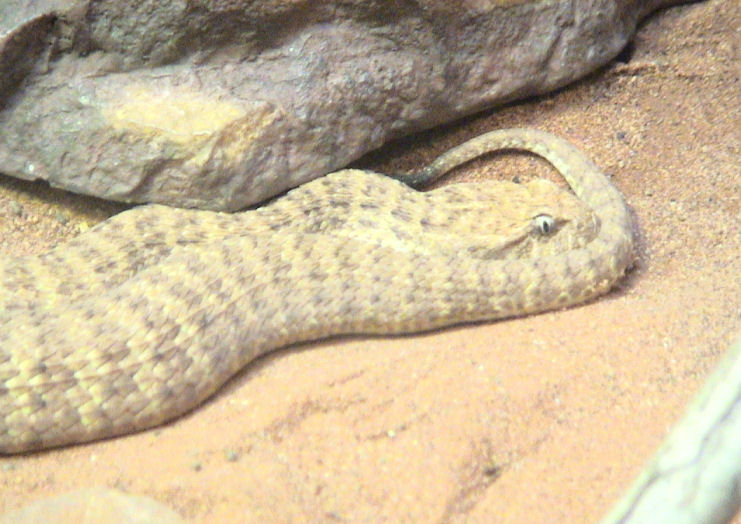|
| Query: Desert death adder | Result: 1st of 5 | |
Desert Death Adder (Acanthophis pyrrhus) - Wiki
| Subject: | Desert Death Adder (Acanthophis pyrrhus) - Wiki
| |

| Resolution: 741x524
File Size: 101275 Bytes
Date: 2006:12:04 10:24:11
Camera: DCR-DVD201E (SONY)
F number: f/1.8
Exposure: 1/50 sec
Focal Length: 181/10
Upload Date: 2007:11:13 10:58:57
|
Desert Death Adder
From Wikipedia, the free encyclopedia
[Photo] Desert Death Adder (Acanthophis pyrrhus) taken at Taronga Zoo, Sydney. Date 4 December 2006. Author http://en.wikipedia.org/wiki/User:Taipan198 | Permission is granted to copy, distribute and/or modify this document under the terms of the GNU Free Documentation License, Version 1.2 or any later version published by the Free Software Foundation; with no Invariant Sections, no Front-Cover Texts, and no Back-Cover Texts. A copy of the license is included in the section entitled "GNU Free Documentation License". |
The Desert Death Adder (Acanthophis pyrrhus), is a species of Death Adder native to Australia and is one of the most venomous land snakes in Australia and the world. Unlike its sister species of Common Death Adders, the Desert Death Adder is under threat due to the destruction of habitat.
Appearance
Desert Deaths Adders are more slender than its counterparts (Common Death Adder) and are broad flattened, with triangular heads and a thin body. They grow to lengths up to 70 centimetres and are rarely larger than this size. Desert Death Adders are often beautifully coloured in brick-red with conspicuous yellow bands. Some are of a dull yellow-reddish colour to blend in with their surrounding. The tail tip is used as a lure to attract potential prey and is distinctively black in colour. Their fangs are longer than most of Australia’s venomous snakes.
Range
The Desert Death Adder occurs over much of Central and Western Australia; protruding west of the Northern Territory.
Habitat
Desert Death Adders are found in living in remote areas, amongst porcupine grass, stony flats, sandy ridges and rocky outcrops of Central and Western Australia.
Behaviour
The desert death adder only bites if the threat is very close to them. They also use their bite to catch their prey. They only bite when they are close to their target.
Diet
Desert Death Adders feed on lizards, especially skinks and dragons. These are attracted to the snake, which may lie in a patient ambush for days, by the wiggling of the lure at the tip of the tail like its sister, the Common Death Adder. When moved it bears a striking resemblance to a worm or caterpillar and is thus a tempting morsel for a passing lizard.
Venom
Desert Death Adders are reluctant to bite unless the threat is very close to them. However, they have large fangs, and their glands produce a considerable quantity of toxic venom. Today, it rarely is the cause of snake bites in Australia.
Reproduction
Desert Death Adders mate during spring or early summer, with the babies being produced in late summer or early autumn. Unlike most other snakes, Desert Death Adders give birth to live young. Up to 13 live young may be produced in each litter.
http://en.wikipedia.org/wiki/Desert_Death_Adder
| The text in this page is based on the copyrighted Wikipedia article shown in above URL. It is used under the GNU Free Documentation License. You may redistribute it, verbatim or modified, providing that you comply with the terms of the GFDL. |
|
^o^
Animal Pictures Archive for smart phones
^o^
|
|

